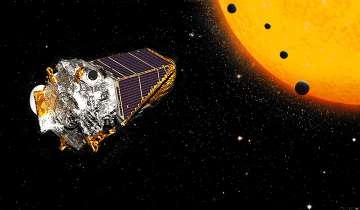Exoplanets which are between two to four times the size of Earth are likely to have vast amounts of water, according to a study that may have implications for the search of alien life in our galaxy.
Data from the exoplanet-hunting Kepler Space Telescope and the Gaia mission indicates that many of the known planets may contain as much as 50 per cent water.
This is much more than the Earth's 0.02 per cent water content, researchers said.
"It was a huge surprise to realise that there must be so many water-worlds," said Li Zeng from Harvard University in the US.
Scientists have found that many of the 4,000 confirmed or candidate exoplanets discovered so far fall into two size categories: those with the planetary radius averaging around 1.5 that of the Earth, and those averaging around 2.5 times the radius of the Earth.
After analysing the exoplanets with mass measurements and recent radius measurements from the Gaia satellite, scientists have developed a model of their internal structure.
"We have looked at how mass relates to radius, and developed a model which might explain the relationship," said Zeng.
The model indicates that those exoplanets which have a radius of around x1.5 Earth radius tend to be rocky planets (of typically x5 the mass of the Earth), while those with a radius of x2.5 Earth radius (with a mass around x10 that of the Earth) are probably water worlds".
"This is water, but not as commonly found here on Earth", said Zeng.
"Their surface temperature is expected to be in the 200 to 500 degree Celsius range. Their surface may be shrouded in a water-vapour-dominated atmosphere, with a liquid water layer underneath," he said.
"Moving deeper, one would expect to find this water transforms into high-pressure ices before we reaching the solid rocky core. The beauty of the model is that it explains just how composition relates to the known facts about these planets," he added.
The data indicates that about 35 per cent of all known exoplanets which are bigger than Earth should be water-rich. These water worlds likely formed in similar ways to the giant planet cores (Jupiter, Saturn, Uranus, Neptune) which we find in our own solar system.
"It's amazing to think that the enigmatic intermediate-size exoplanets could be water worlds with vast amounts of water. Hopefully atmosphere observations in the future -- of thick steam atmospheres -- can support or refute the new findings," said Sara Seager, a professor at Massachusetts Institute of Technology in the US.

